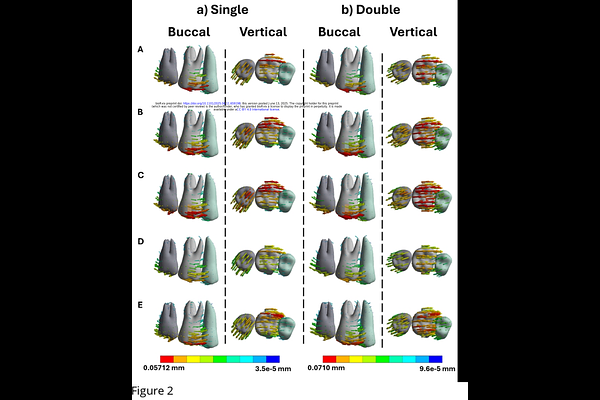EFFECTS OF ATTACHMENT DESIGNS ON CLEAR ALIGNER TOOTH MOVEMENT: A FINITE ELEMENT ANALYSIS

EFFECTS OF ATTACHMENT DESIGNS ON CLEAR ALIGNER TOOTH MOVEMENT: A FINITE ELEMENT ANALYSIS
Mamboleo, E.; Ouldyerou, A.; Alsharif, K.; Ngan, P.; Guan, G.; Merdji, A.; Mukdadi, O.; Egon Mamboleo, Abdelhak Ouldyerou, Khaled Alsharif, Peter Ngan, Guoqiang Guan, Ali Merdji, and Osama,
AbstractThis study investigates the impact of different attachment shapes and configurations on the displacement, stress, and strain profiles of maxillary first molar during clear aligner-based orthodontic treatment. A subject-specific 3D maxillary model was developed from CBCT imaging, incorporating cortical and trabecular bone, periodontal ligament (PDL), teeth, attachments, and aligner geometry. Five attachment shapes square, rectangle, trapezoid, ellipse, and semicircle were analyzed in single and dual (buccal-lingual) configurations across four clinically relevant movements: mesialization, intrusion, extrusion, and rotation. Finite-element simulation results indicated that flat-shaped attachments (rectangular and trapezoidal) generated the greatest crown displacement but induced higher PDL strain (up to 0.390 mm/mm) and localized bone stress (7.11 MPa), particularly at the root apex and alveolar crest. Curved attachments provided more diffused load distribution but significantly reduced movement efficiency. Dual attachments improved root engagement and bodily displacement in all movement types, mitigating undesired tipping and enhancing force symmetry, albeit with elevated strain. Rotational control was most influenced by attachment geometry, with flat designs producing greater angular movement. Overall, attachment shape and placement exert a substantial influence on orthodontic biomechanics during aligner therapy. The findings underscore the need for evidence-based attachment protocols tailored to specific movement goals and patient risk profiles. These insights can guide clinicians toward optimizing clear aligner treatments for improved movement precision, minimized biological risk, and enhanced treatment outcomes in complex orthodontic cases.